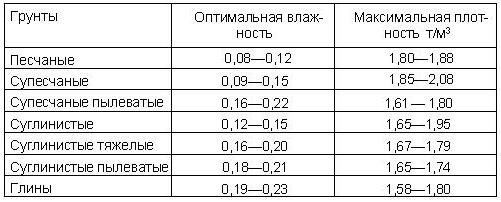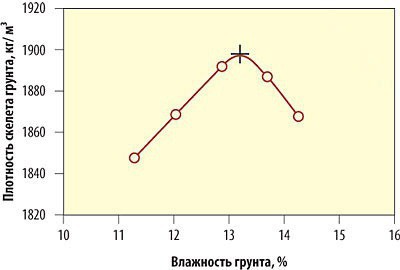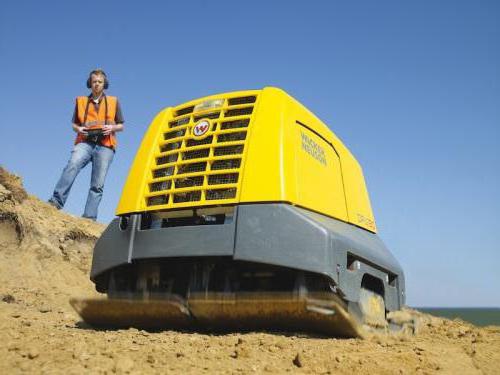Preparing for development, they conduct special studies and tests that determine the suitability of the site for the upcoming work: they take soil samples, calculate the groundwater level and explore other soil features that help determine the possibility (or lack thereof) of construction.

Carrying out such measures helps to increase technical indicators, as a result of which a number of problems arising in the construction process are solved, for example, subsidence of soil under the weight of the structure with all the ensuing consequences. Its first external manifestation looks like the appearance of cracks on the walls, and in combination with other factors, to partial or complete destruction of the object.
Compaction Ratio: What is it?
By soil compaction coefficient we mean a dimensionless indicator, which, in essence, is a calculation from the ratio of soil density / soil densitymax. The soil compaction coefficient is calculated taking into account geological indicators. Any of them, regardless of breed, is porous. It is penetrated by microscopic voids, which are filled with moisture or air. During the development of the soil, the volume of these voids increases significantly, which leads to an increase in the friability of the rock.

Important! The density index of bulk rock is much less than the same characteristics of rammed soil.
It is the soil compaction coefficient that determines the need to prepare the site for construction. Based on these indicators, sand cushions are prepared for the foundation and its foundation, further compacting the soil. If this part is missed, it may cake and under the weight of the structure will begin to sag.
Soil compaction rates
The soil compaction coefficient indicates the level of soil compaction. Its value varies from 0 to 1. For the foundation of a concrete strip foundation, a figure of> 0.98 points is considered the norm.
The specifics of determining the coefficient of compaction
The density of the skeleton of the soil, when the subgrade is amenable to standard compaction, is calculated in laboratory conditions. The basic scheme of the study is to place a soil sample in a steel cylinder, which is compressed under the influence of an external brute mechanical force - impacts of a falling load.
Important! The highest indicators of soil density are observed in rocks with humidity slightly above normal. This dependence is depicted in the graph below.

Each subgrade has its own optimum humidity, at which the maximum level of compaction is achieved. This indicator is also investigated in laboratory conditions, giving the rock different moisture and comparing the compaction indicators.
Real data is the end result of research, measured at the end of all laboratory work.
Compaction Methods and Ratio Calculations
The geographical location determines the qualitative composition of soils, each of which has its own characteristics: density, humidity, and the ability to sag. Therefore, it is so important to develop a set of measures aimed at the qualitative improvement of characteristics for each type of soil.
You already know the concept of compaction coefficient, the subject of which is studied strictly in the laboratory. The relevant services carry out such work. The soil compaction index determines the method of impact on the soil, as a result of which it will receive new strength characteristics. When conducting such actions, it is important to consider the percentage of gain applied to obtain the desired result.Based on this, the soil compaction coefficient is subtracted (table below).

Typology of soil compaction methods
There is a conditional subdivision system for compaction methods, the groups of which are formed based on the method of achieving the goal - the process of removing oxygen from soil layers at a certain depth. So, distinguish between superficial and in-depth research. Based on the type of research, specialists select a system of equipment and determine the method of its application. Soil research methods are:
- static
- vibrating;
- drums;
- combined.
Each type of equipment displays a method of applying force, such as a pneumatic roller.

Partially, such methods are used in small private construction, others exclusively in the construction of large-scale facilities, the construction of which is agreed with the local authorities, since some of these structures can affect not only a given area, but also the surrounding facilities.
Sealing factors and SNiP norms
All operations related to construction are clearly regulated by law, therefore they are strictly controlled by the relevant organizations.
The compaction coefficients of soils SNiP determines paragraph 3.02.01-87 and SP 45.13330.2012. The actions described in the regulatory documents were updated and updated in 2013-2014. They describe compaction for various types of soil and soil pillows used in the construction of foundations and buildings of various configurations, including underground ones.

How is the compaction coefficient determined?
The easiest way is to determine the soil compaction coefficient by the method of cutting rings: a metal ring of a selected diameter and a certain length is driven into the ground, during which time the rock is tightly fixed inside the steel cylinder. After that, the mass of the device is measured on the scales, and at the end of the weighing, the weight of the ring is subtracted, obtaining a clean soil mass. This number is divided by the volume of the cylinder and the final soil density is obtained. Then it is divided by the maximum possible density indicator and get the calculated - compaction coefficient for this section.
Compression coefficient calculation examples
Consider the determination of the soil compaction coefficient by the example:
- value of maximum soil density - 1.95 g / cm3;
- diameter of the cutting ring - 5 cm;
- cutting ring height - 3 cm.
It is necessary to determine the soil compaction coefficient.
It is much easier to cope with such a practical task than it might seem.
To begin with, the cylinder is completely driven into the ground, after which it is removed from the soil so that the interior remains filled with earth, but no accumulation of soil is noted outside.
Using a knife, the soil is removed from the steel ring and weighed.
For example, the mass of soil is 450 grams, the volume of the cylinder is 235.5 cm3. Calculating by the formula, we obtain the number 1.91 g / cm3 - soil density, whence the soil compaction coefficient - 1.91 / 1.95 = 0.979.
The construction of any building or structure is a responsible process, which is preceded by an even more crucial moment in the preparation of the built-up area, the design of the proposed buildings, and the calculation of the total soil load. This applies to all buildings without exception, which are designed for long-term operation, the period of which is measured in tens or even hundreds of years.